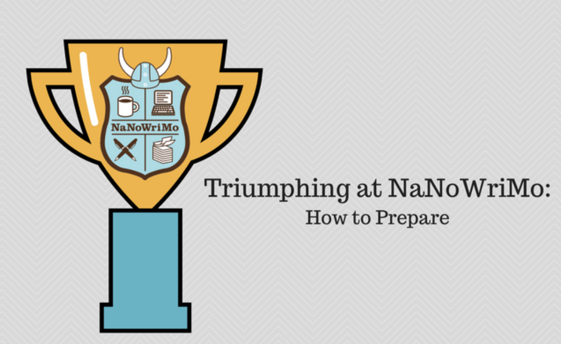
Are you ready for NaNoWriMo?
It’s the question most asked this time of year, right before National Novel Writing Month (NaNoWriMo) that takes over the month of November every year.
If this is your first time doing NaNoWriMo, don’t stress out too much about it. It’s a huge learning process where you’ll discover what’s most important for you to be able to produce content on a continual basis to move forward towards your end goal of 50,000 words in 30 days.
The biggest lesson I’ve learned over the years is that it’s not so much about the end result. What you have at the end of 30 days will in no shape or form be a novel ready to print. Depending on your genre, novels can be 80,000 words and up. Just understand: you won’t be finished with it on November 30th.
What NaNoWriMo is about is learning how to let go—especially of your internal editor—and just write. Just go with the flow. Just let it happen. Because there will never be a novel if you don’t get it down on paper first.
You could think of it this way—the 30 days in November might give you a short, rough draft of your novel. Then you can spend December fleshing it out with more substance, wordsmithing it, and generally making it more presentable.
And the best way to attack NaNoWriMo is to get ready for it, much like you would prepare for any marathon event. Here are the best tips around to get ready to write your novel in 30 days.
- Create a visual calendar for motivation. You can use a standard desk calendar or a fancy whiteboard calendar to hang on the wall. Just get something with 30 days’ worth of boxes that you can put a big, red X through when you’ve reached your word count for the day. As you progress and the X’s start to join together in a nifty pattern, you’ll be motived to not break the chain.
- Find your writing habitat. Every living thing has a habitat that helps it survive, and you need to learn your writing habitat. Depending on your personality, writing doesn’t have to be a solitary endeavor. There are coffee shops, libraries, and other locations that might work better for you than sitting at home alone. Part of your writing habitat is learning when is the best time for you to write. Some people are best first thing in the morning, immediately after getting up. Others are best in the late hours of the evening. Just make sure your writing habitat contains plenty of caffeinated beverages, chocolate, and your favorite playlist. You may want to spend some time in the weeks before November determining when and where you write best. Once you figure it out, block out that time on your calendar.
- Plan or don’t plan. That’s up to you. The first year I tried NaNoWriMo, I had a great idea and went full force at it for the first week of November. By the second week, I realized I didn’t know my characters well enough to figure out where they should go from there. The next year, I did a rough outline and some character sketches, and found it easier to keep forward motion. So, plan or don’t plan according to your tastes. One thing you can do that helps you plan a little and also offers incredible motivation is to create a dust jacket for your new novel. You’ll have to identify the characters, what they want, and what’s standing in their way in order to write your dust jacket. Once it’s done, put it up on your desk where you’ll see it every day.
- Make it public. When you make your commitment to NaNoWriMo public by telling friends and family, it might help you to keep chugging along. A little peer pressure can go a long way, too. Join a NaNoWriMo group (you can find one close to your home at www.nanowrimo.org), or if it works better for you, find an online community of writers to join. There’s nothing better than sharing this experience with a group of like-minded people who understand the struggle. Another key benefit of going public is to let people know that you won’t be available during November because you’ll be writing.
Spend a few weeks in October to implement the above tips. Consider doing a trial run for a week and write down the details of your writing sessions:
- Location
- Time of day
- How long you write for
- Any background noise you need
- How many words you write
- What distracted you
- What your mood was like
Mix up your routine every day, at the end of the week, you’ll have a pretty thorough idea of how, where, and when you write best.
Final Thoughts
I can’t stress enough that you need the right mindset before you attempt NaNoWriMo. Be prepared to write some crappy sentences during November. It’s not about writing beautifully. It’s about getting the bare bones of your novel down on paper so you have something to work with going forward.
Have you checked out our new e-book? It's perfect for helping you prepare for NaNoWriMo. We're offering it for FREE this month to help you prepare for NaNo 2019. Click here to download it now!
Interested in NaNoWriMo? Check out these posts from our archive:

